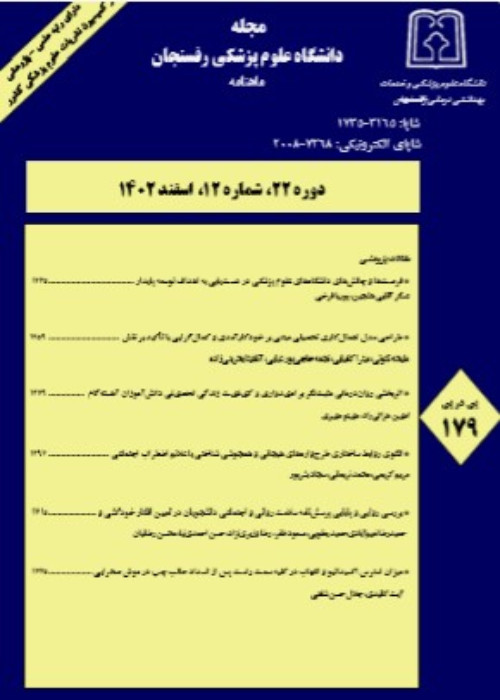Comparison Between the Contents of Phenolic and Flavonoid Compounds and Aerial Part Antioxidant Activity in Scutellaria pinnatifida in Two NorthIranian Populations
Author(s):
Abstract:
Background And Objective
Phenolic acids, polyphenols and flavonoids are antioxidant compounds, which act as cell protective factors against oxidative stress by trapping and inhibition of free radicals, play an important role in plants and animals health. In this research, in order to optimize extraction of antioxidant compounds, phenolic and flavonoid contents and antioxidant activity of Scutellaria pinnatifida aerial part were determined.Materials And Methods
Dried powder of aerial part from two populations, Dizin and Kojur, was extracted with ethanol 80%, methanol 80%, water and ethyl acetate, by two soaking and sonication methods. Then, the contents of total phenolic and flavonoid compounds were assayed by spectrophotometric methods. Antioxidant activity of the extracts were analyzed by two tests: free radical scavenging activity using the 2,2-diphenyl-1-picrylhydrazyl (DPPH) and bleaching β-carotene in linoleic acid system. Statistical analysis of the data was performed by One-way and two-way ANOVA to compare the means. Results
The highest content of total phenol and flavonoid (8 and 24 mg/g Shoot dry weight, respectively) was obtained by soaking method and ethanolic extraction in Kojur population. While in Dizin population with the same extraction techniques, the contents of the mentioned compounds were at very low levels (5.6 and 1.6 mg/g DW, respectively). IC50 value of the ethanolic, methanolic and aqueous extracts were estimated about 0.1- 1.2 mg/ml in the Kojur population. The phenolic and flavonoid contents of these extracts were significantly higher than ethyl acetate extracts. With the exception of aqueous extract prepared by soaking, scavenging capacity of DPPH free radicals by different extracts of Dizin population was considerably lower than the Kojour population. The antioxidant assay results obtained from beta-carotene-linoleic acid test showed that the highest inhibition percentage of lipid peroxidation resulted from aqueous extracts prepared by ultrasonic waves (respectively 93% and 50% inhibition by extracts of the Kojour and Dizin populations).Conclusion
The means of total phenolic and flavonoid contents of the extracts were significantly different under the influence of three factors: population, extraction method and solvent. The highest antioxidant activity was observed in Kojur population: by soaking methanolic extraction method in DPPH test or by sonicate aqueous extraction method in the inhibition of lipid peroxidation test.Keywords:
Language:
Persian
Published:
Journal of Rafsanjan University Of Medical Sciences, Volume:13 Issue: 3, 2014
Pages:
249 to 266
magiran.com/p1325225
دانلود و مطالعه متن این مقاله با یکی از روشهای زیر امکان پذیر است:
اشتراک شخصی
با عضویت و پرداخت آنلاین حق اشتراک یکساله به مبلغ 1,390,000ريال میتوانید 70 عنوان مطلب دانلود کنید!
اشتراک سازمانی
به کتابخانه دانشگاه یا محل کار خود پیشنهاد کنید تا اشتراک سازمانی این پایگاه را برای دسترسی نامحدود همه کاربران به متن مطالب تهیه نمایند!
توجه!
- حق عضویت دریافتی صرف حمایت از نشریات عضو و نگهداری، تکمیل و توسعه مگیران میشود.
- پرداخت حق اشتراک و دانلود مقالات اجازه بازنشر آن در سایر رسانههای چاپی و دیجیتال را به کاربر نمیدهد.
In order to view content subscription is required
Personal subscription
Subscribe magiran.com for 70 € euros via PayPal and download 70 articles during a year.
Organization subscription
Please contact us to subscribe your university or library for unlimited access!


